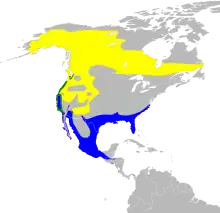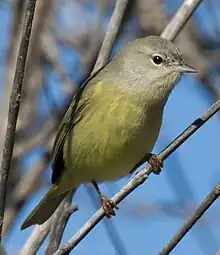| Orange-crowned warbler | |
|---|---|
 | |
| Scientific classification | |
| Domain: | Eukaryota |
| Kingdom: | Animalia |
| Phylum: | Chordata |
| Class: | Aves |
| Order: | Passeriformes |
| Family: | Parulidae |
| Genus: | Leiothlypis |
| Species: | L. celata |
| Binomial name | |
| Leiothlypis celata (Say, 1822) | |
 | |
| Range of L. celata Breeding range Year-round range Wintering range | |
| Synonyms | |
|
Helmintophila celata | |
_crown_visible.jpg.webp)
The orange-crowned warbler (Leiothlypis celata) is a small songbird of the New World warbler family.
Taxonomy
The orange-crowned warbler was formally described in 1822 by the American zoologist Thomas Say under the binomial name Sylvia celatus from a specimen collected on an expedition from Pittsburgh to the Rocky Mountains led by Stephen Harriman Long.[2] The specific epithet celatus is Latin and means "secret" or "hidden".[3] The type locality is Omaha, Nebraska.[4] The orange-crowned warbler is now placed in the genus Leiothlypis that was introduced by the Dutch ornithologist George Sangster in 2008. The genus name is derived from the Ancient Greek λειος/leios meaning "plain" and θλυπις/thlupis, an unknown small bird mentioned by Aristotle.[5][6]
Four subspecies are recognised:[6]
- L. c. celata (Say, 1822) – breeds in central Alaska to south Canada, winters in Guatemala
- L. c. lutescens (Ridgway, 1872) – breeds in west Canada and west USA, winters in Guatemala
- L. c. orestera (Oberholser, 1905) – breeds in west central Canada and west central USA, winters in Mexico
- L. c. sordida (Townsend, CH, 1890) – resident in south California (southwest USA) and northwest Mexico
Description

The orange-crowned warbler has olive-grey upperparts, yellowish underparts with faint streaking and a thin pointed bill. It has a faint line over each eye and a faint broken eye ring. The orange patch on the crown is usually not visible. Females and immatures are duller in colour than males. Western birds are yellower than eastern birds. Orange-crowned warblers are distinguished by their lack of wing bars, streaking on the underparts, strong face marking or bright colouring, resembling a fall Tennessee warbler and a black-throated blue warbler, both of which are also members of the New World warbler family.
The song of is a trill, descending in pitch and volume. The call is a high chip.
| Standard Measurements[7][8] | |
|---|---|
| length | 4.8–5.3 in (120–130 mm) |
| weight | 9 g (0.32 oz) |
| wingspan | 7.25 in (184 mm) |
| wing | 56.9–62.5 mm (2.24–2.46 in) |
| tail | 46–51.5 mm (1.81–2.03 in) |
| culmen | 10–11.2 mm (0.39–0.44 in) |
| tarsus | 16.5–18.5 mm (0.65–0.73 in) |
Distribution and habitat
Their breeding habitat is open shrubby areas across Canada, Alaska and the western United States. These birds migrate in the winter to the southern United States and south to Central America. Although they are quite common in the western United States, they are uncommon in the east.[9]
Behaviour and ecology
Breeding

The nest is a small open cup well-concealed on the ground under vegetation or low in shrubs. The female builds the nest; four to six eggs are laid in a nest on the ground or in a low bush. Both parents feed the young.[7]
Food and feeding
They forage actively in low shrubs, flying from perch to perch, sometimes hovering. These birds eat insects, berries and nectar.[9]
References
- ↑ BirdLife International (2016). "Leiothlypis celata". IUCN Red List of Threatened Species. 2016: e.T22721624A94718199. doi:10.2305/IUCN.UK.2016-3.RLTS.T22721624A94718199.en. Retrieved 18 November 2021.
- ↑ Say, Thomas (1823). "Animals — Sioux and Omawhaw Indians — Winter residence". In James, Edwin (ed.). Account of an expedition from Pittsburgh to the Rocky Mountains, performed in the years 1819 and '20 : by order of the Hon. J.C. Calhoun, sec'y of war: under the command of Major Stephen H. Long. From the notes of Major Long, Mr. T. Say, and other gentlemen of the exploring party. Vol. 1. Philadelphia: H.C. Carey and I. Lea. pp. 167–199 [169–170]. Although the year is given as 1823 on the title page, the volume was actually published on 31 December 1822. See: Woodman, Neal (2010). "History and dating of the publication of the Philadelphia (1822) and London (1823) editions of Edwin James's Account of an expedition from Pittsburgh to the Rocky Mountains". Archives of Natural History. 37 (1): 28–38. doi:10.3366/E0260954109001636.
- ↑ Jobling, James A. (2010). The Helm Dictionary of Scientific Bird Names. London: Christopher Helm. p. 96. ISBN 978-1-4081-2501-4.
- ↑ Paynter, Raymond A. Jr, ed. (1968). Check-List of Birds of the World. Vol. 14. Cambridge, Massachusetts: Museum of Comparative Zoology. p. 7.
- ↑ Sangster, George (2008). "A revision of Vermivora (Parulidae) with the description of a new genus". Bulletin of the British Ornithologists' Club. 128: 207–211 [210–211].
- 1 2 Gill, Frank; Donsker, David; Rasmussen, Pamela, eds. (2020). "New World warblers, mitrospingid tanagers". IOC World Bird List Version 10.1. International Ornithologists' Union. Retrieved 2 October 2020.
- 1 2 Godfrey, W. Earl (1966). The Birds of Canada. Ottawa: National Museum of Canada. p. 323.
- ↑ Sibley, David Allen (2000). The Sibley Guide to Birds. New York: Knopf. p. 427. ISBN 0-679-45122-6.
- 1 2 Gilbert, William M.; Sogge, Mark K.; van Riper, C. (2020). "Orange-crowned Warbler (Leiothlypis celata), version 1.0". Birds of the World. doi:10.2173/bow.orcwar.01. S2CID 216482621.
- Peluc, S.I.; Sillett, T.S.; Rotenberry, J.T.; Ghalambor, C.K. (2008). "Adaptive plasticity in nest site selection in response to increased predation risk". Behavioral Ecology. 19: 830–835. doi:10.1093/beheco/arn033.
External links
- Orange-crowned warbler - Island Misfits at Smithsonian Migratory Bird Center
- Orange-crowned warbler species account - Cornell Lab of Ornithology
- Orange-crowned warbler - Vermivora celata - USGS Patuxent Bird Identification InfoCenter
- BirdLife species factsheet for Vermivora celata
- "Oreothlypis celata". Avibase.
- "Orange-crowned warbler media". Internet Bird Collection.
- Orange-crowned warbler photo gallery at VIREO (Drexel University)
- Audio recordings of Orange-crowned warbler on Xeno-canto.
